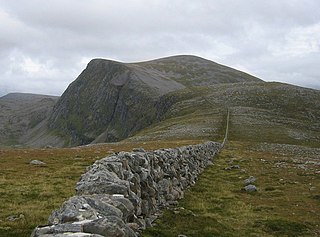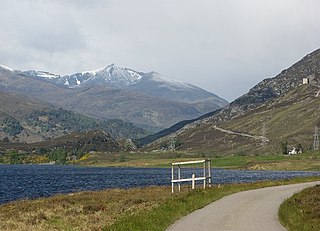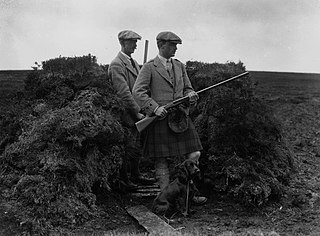| Formation | 1993 [1] |
|---|---|
| Type | Conservation charity |
| Location |
|
Area served | Scottish Highlands |
| Revenue | £4,162,000 (2023) |
| Website | https://treesforlife.org.uk/ |
Trees for Life is a registered charity working to rewild the Scottish Highlands.
Contents


| Formation | 1993 [1] |
|---|---|
| Type | Conservation charity |
| Location |
|
Area served | Scottish Highlands |
| Revenue | £4,162,000 (2023) |
| Website | https://treesforlife.org.uk/ |
Trees for Life is a registered charity working to rewild the Scottish Highlands.


Trees for Life states that its long-term plan is to see Dundreggan restored to a wild landscape of diverse natural forest cover, with the return of native wildlife. Rewilding supports nature, climate and people by boosting biodiversity, creating jobs, and supporting re-peopling.
Trees for Life was founded in 1986 by Alan Watson Featherstone, as a project under the Findhorn Foundation. Practical work began in 1989, and the first volunteer week was held in 1991. Trees for Life registered as an independent charity in 1993.
Trees for Life works to restore the Caledonian Forest, especially in Glen Affric where one of the most important fragments of Caledonian Forest survived. [2] In August 2008 Trees for Life purchased the 10,000 acre Dundreggan Estate in Glenmoriston, in the Scottish Highlands – one of the largest areas in the UK to be bought for forest restoration. [3]
In 2020, golden eagles returned to breed for the first time in 40 years. [4]
The charity established the Dundreggan Rewilding Centre, the first of its kind in the world, which opened in April 2023 at the Dundreggan Estate. [5]

Initial work took place in Glen Cannich. TFL also supported woodland creation in Glen Affric, where they operate in partnership with Forestry and Land Scotland and the National Trust for Scotland. Work expanded into other nearby glens, such as Glenmoriston, to the south of Glen Affric, at Achnashellach, and at Corrimony, where they partnered with the Royal Society for the Protection of Birds.[ citation needed ]
Affric Highlands is a 30-year collaborative initiative by Trees for Life and Rewilding Europe who are working to restore woodland, peatland and riverside habitats in the Scottish Highlands. [6]
In June 2022, Affric Highlands was recommended for UN flagship status by the Scottish and UK governments. [7]


The Woodland Trust is the largest woodland conservation charity in the United Kingdom and is concerned with the creation, protection, and restoration of native woodland heritage. It has planted over 68 million trees since 1972. The Woodland Trust has three aims: to protect ancient woodland which is rare, unique and irreplaceable, to promote the restoration of damaged ancient woodland, and to plant native trees and woods to benefit people and wildlife.

Drumnadrochit is a village in the Highland local government council area of Scotland, lying near the west shore of Loch Ness at the foot of Glen Urquhart. The village is close to several neighbouring settlements: the villages of Milton to the west, Kilmore to the east and Lewiston to the south. The villages act as a centre for regional tourism beside Loch Ness, as well as being a local economic hub for the nearby communities.

The Caledonian Forest is the ancient (old-growth) temperate forest of Scotland. The forest today is a reduced-extent version of the pre-human-settlement forest, existing in several dozen remnant areas.

Dudley Coutts Marjoribanks, 1st Baron Tweedmouth, also known as the Laird of Guisachan and Glenaffric, was a Scottish businessman and a Liberal politician who sat in the House of Commons from 1853 until 1880, when he was elevated to the peerage as Baron Tweedmouth. He was the breeder of the first golden retriever.

Ben Wyvis is a mountain in Easter Ross, in the northern Highlands of Scotland. It lies north-west of Dingwall, in the council area of Highland, and the county of Ross and Cromarty. Ben Wyvis is a large winding and undulating ridge running roughly north–south for about 5 km, the highest point of which is Glas Leathad Mòr at 1,046 metres (3,432 ft). Geologically, the ridge is composed of Moine pelitic gneiss. The mountain is prominent in views of the area, presenting a whale-back shape above the farmland of Strathconon.

The John Muir Trust (JMT) is a Scottish charity, established in 1983 to conserve wild land and wild places for the benefit of all. The Trust runs an environmental award scheme, manages several estates, mainly in the Highlands and Islands of Scotland and campaigns for better protection of wild land. In 2017, it took on a lease to manage Glenridding Common in the English Lake District.

Glen Affric is a glen south-west of the village of Cannich in the Highland region of Scotland, some 15 miles west of Loch Ness. The River Affric runs along its length, passing through Loch Affric and Loch Beinn a' Mheadhoin. A minor public road reaches as far as the end of Loch Beinn a' Mheadhoin, but beyond that point only rough tracks and footpaths continue along the glen.

Beinn Dearg is a mountain in the Inverlael area of the Highlands of Scotland. It is most frequently climbed by following the River Lael up Gleann na Sguaib. Starting from near the head of Loch Broom, a path follows the glen to a bealach, which is about one kilometre north of the summit. From this bealach, the neighbouring peaks of Cona' Mheall and Meall na Ceapraichean may also be climbed. Eididh nan Clach Geala, which lies about three kilometres north of Beinn Dearg, is also added in to complete a round of four Munros.
The Northwest Highlands are located in the northern third of Scotland that is separated from the Grampian Mountains by the Great Glen. The region comprises Wester Ross, Assynt, Sutherland and part of Caithness. The Caledonian Canal, which extends from Loch Linnhe in the south-west, via Loch Ness to the Moray Firth in the north-east splits this area from the rest of the country. The city of Inverness and the town of Fort William serve as gateways to the region from the south.

Mam Sodhail, or Màm Sabhail in Gaelic, sometimes anglicised "Mam Soul", is a mountain with a height of 1,181 metres (3,875 ft) in the Northwest Highlands of Scotland. Classed as a Munro, it is beside Carn Eige in the secluded country on the northern side of Glen Affric, some 30 kilometres east of Kyle of Lochalsh.

The deer forest is a sporting estate which is kept and managed largely or solely for the purposes of maintaining a resident population of red deer for sporting purposes. It is an institution and phenomenon peculiar to the Highlands of Scotland.

Glen Strathfarrar is a glen in the Highland region of Scotland, near Loch Ness.

Glenmoriston or Glen Moriston is a river glen in the Scottish Highlands, that runs from Loch Ness, at the village of Invermoriston, westwards to Loch Cluanie, where it meets with Glen Shiel. The A887 and A87 roads pass through Glenmoriston.

Driven grouse shooting is a field sport in the United Kingdom involving the shooting of red grouse. It is one of two forms of the sport; the other is walked-up shooting. Driven grouse shooting involves grouse being driven to fly over people with shotguns in fixed positions. In walked-up shooting the participants walk forward in a line and flush the birds as they go. Walked-up shooting is more physically demanding than a driven shoot and typically involves fewer birds being shot.

Scotland is ideal for tree growth, thanks to its mild winters, plentiful rainfall, fertile soil and hill-sheltered topography. As of 2019 about 18.5% of the country was wooded. Although this figure is well below the European Union (EU) average of 43%, it represents a significant increase compared to the figure of 100 years previously: in 1919 it was estimated that only 5% of the country's total land area was covered in forest. The Scottish Government's Draft Climate Change Plan has set an aim of increasing coverage to 21% of Scotland by 2032, with the rate of afforestation rising to 15,000 hectares per year by 2024.
Alan Watson Featherstone is a Scottish ecologist. He is a natural history photographer, speaker and the founder of the conservation charity Trees for Life.

Glen Tanar is a glen in Aberdeenshire, eastern Scotland, through which the Water of Tanar flows. Near the mouth of the glen, at Tower o' Ess, the Water of Tanar flows into the River Dee. This flows through Deeside into the North Sea at Aberdeen. Glen Tanar contains the third largest area of Caledonian Forest in Scotland, and is of national and European importance. It lies 29 km east from the British royal family's private residence of Balmoral Castle.

The Last Ent of Affric is an ancient elm in the Scottish Highlands, designated a Tree of National Special Interest (TNSI) by the Woodland Trust and named Scotland's Tree of the Year in 2019. It is probably the last surviving tree of an ancient forest, and by virtue of its isolation has remained safe from Dutch elm disease.

Loch Beinn a' Mheadhoin is a freshwater loch in Inverness-shire, Scotland. It is one of several lochs in Glen Affric, a National Nature Reserve within Scotland's Caledonian Forest.